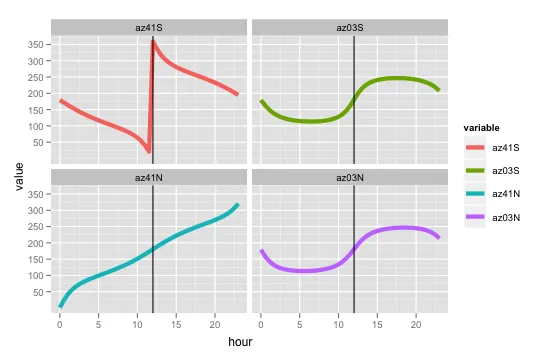这个问题在三年多前就被问过了。曾经有人给出了答案,但我发现了解决方案中的一个小问题。
下面的代码是用R编写的。我已经将它移植到另一种语言中,但为了确保问题不是由于我的移植造成的,我直接在R中测试了原始代码。
sunPosition <- function(year, month, day, hour=12, min=0, sec=0,
lat=46.5, long=6.5) {
twopi <- 2 * pi
deg2rad <- pi / 180
# Get day of the year, e.g. Feb 1 = 32, Mar 1 = 61 on leap years
month.days <- c(0,31,28,31,30,31,30,31,31,30,31,30)
day <- day + cumsum(month.days)[month]
leapdays <- year %% 4 == 0 & (year %% 400 == 0 | year %% 100 != 0) & day >= 60
day[leapdays] <- day[leapdays] + 1
# Get Julian date - 2400000
hour <- hour + min / 60 + sec / 3600 # hour plus fraction
delta <- year - 1949
leap <- trunc(delta / 4) # former leapyears
jd <- 32916.5 + delta * 365 + leap + day + hour / 24
# The input to the Atronomer's almanach is the difference between
# the Julian date and JD 2451545.0 (noon, 1 January 2000)
time <- jd - 51545.
# Ecliptic coordinates
# Mean longitude
mnlong <- 280.460 + .9856474 * time
mnlong <- mnlong %% 360
mnlong[mnlong < 0] <- mnlong[mnlong < 0] + 360
# Mean anomaly
mnanom <- 357.528 + .9856003 * time
mnanom <- mnanom %% 360
mnanom[mnanom < 0] <- mnanom[mnanom < 0] + 360
mnanom <- mnanom * deg2rad
# Ecliptic longitude and obliquity of ecliptic
eclong <- mnlong + 1.915 * sin(mnanom) + 0.020 * sin(2 * mnanom)
eclong <- eclong %% 360
eclong[eclong < 0] <- eclong[eclong < 0] + 360
oblqec <- 23.429 - 0.0000004 * time
eclong <- eclong * deg2rad
oblqec <- oblqec * deg2rad
# Celestial coordinates
# Right ascension and declination
num <- cos(oblqec) * sin(eclong)
den <- cos(eclong)
ra <- atan(num / den)
ra[den < 0] <- ra[den < 0] + pi
ra[den >= 0 & num < 0] <- ra[den >= 0 & num < 0] + twopi
dec <- asin(sin(oblqec) * sin(eclong))
# Local coordinates
# Greenwich mean sidereal time
gmst <- 6.697375 + .0657098242 * time + hour
gmst <- gmst %% 24
gmst[gmst < 0] <- gmst[gmst < 0] + 24.
# Local mean sidereal time
lmst <- gmst + long / 15.
lmst <- lmst %% 24.
lmst[lmst < 0] <- lmst[lmst < 0] + 24.
lmst <- lmst * 15. * deg2rad
# Hour angle
ha <- lmst - ra
ha[ha < -pi] <- ha[ha < -pi] + twopi
ha[ha > pi] <- ha[ha > pi] - twopi
# Latitude to radians
lat <- lat * deg2rad
# Azimuth and elevation
el <- asin(sin(dec) * sin(lat) + cos(dec) * cos(lat) * cos(ha))
az <- asin(-cos(dec) * sin(ha) / cos(el))
elc <- asin(sin(dec) / sin(lat))
az[el >= elc] <- pi - az[el >= elc]
az[el <= elc & ha > 0] <- az[el <= elc & ha > 0] + twopi
el <- el / deg2rad
az <- az / deg2rad
lat <- lat / deg2rad
return(list(elevation=el, azimuth=az))
}
我遇到的问题是它返回的方位似乎是错误的。例如,如果我在0ºE和41ºS、3ºS、3ºN和41ºN的位置上在(南半球)夏至12:00运行函数:
> sunPosition(2012,12,22,12,0,0,-41,0)
$elevation
[1] 72.42113
$azimuth
[1] 180.9211
> sunPosition(2012,12,22,12,0,0,-3,0)
$elevation
[1] 69.57493
$azimuth
[1] -0.79713
Warning message:
In asin(sin(dec)/sin(lat)) : NaNs produced
> sunPosition(2012,12,22,12,0,0,3,0)
$elevation
[1] 63.57538
$azimuth
[1] -0.6250971
Warning message:
In asin(sin(dec)/sin(lat)) : NaNs produced
> sunPosition(2012,12,22,12,0,0,41,0)
$elevation
[1] 25.57642
$azimuth
[1] 180.3084
这些数字似乎不太对。我对高度感到满意——前两个应该大致相同,第三个应该稍微低一些,第四个则要低得多。然而,第一个方位角应该大致朝北,但它给出的数字完全相反。剩下的三个应该大致指向正南,但只有最后一个是这样的。中间的两个指向稍微偏北,再次180度错误。
如您所见,在低纬度(接近赤道)的情况下也会触发一些错误。
我认为问题在于这一部分,在第三行触发错误(以elc开头)。
# Azimuth and elevation
el <- asin(sin(dec) * sin(lat) + cos(dec) * cos(lat) * cos(ha))
az <- asin(-cos(dec) * sin(ha) / cos(el))
elc <- asin(sin(dec) / sin(lat))
az[el >= elc] <- pi - az[el >= elc]
az[el <= elc & ha > 0] <- az[el <= elc & ha > 0] + twopi
我在谷歌上搜索并找到了一段类似的C代码,在转换成R代码时,用来计算方位角的那行代码应该是这样的
az <- atan(sin(ha) / (cos(ha) * sin(lat) - tan(dec) * cos(lat)))
这里的输出似乎朝着正确的方向发展,但每次转换回度数时我都无法始终得到正确的答案。
如果能更正代码(怀疑只是上面几行),使其计算出正确的方位角,那就太棒了。

ephem甚至可以考虑观察者的海拔高度以及大气层的折射(受温度、压力影响)。 - jfs